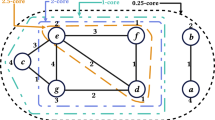Abstract
The diameter-constrained minimum spanning tree problem is an NP-hard combinatorial optimization problem that seeks a minimum cost spanning tree with a limit D imposed upon the length of any path in the tree. We begin by presenting four constructive greedy heuristics and, secondly, we present some second-order heuristics, performing some improvements on feasible solutions, hopefully leading to better objective function values. We present a heuristic with an edge exchange mechanism, another that transforms a feasible spanning tree solution into a feasible diameter-constrained spanning tree solution, and finally another with a repetitive mechanism. Computational results show that repetitive heuristics can improve considerably over the results of the greedy constructive heuristics, but using a huge amount of computation time. To obtain computational results, we use instances of the problem corresponding to complete graphs with a number of nodes between 20 and 60 and with the value of D varying between 4 and 9.
Similar content being viewed by others
References
A. Abdalla and N. Deo, “Random-tree diameter and the diameter-constrained MST,” Int. J. Comput. Math., 79 (2002).
A. Abdalla, N. Deo, and R. Fraceschini, “Parallel heuristics for the diameter-constrained minimum spanning tree,” Congres. Numer., 136, 97–118 (1999).
A. Abdalla, N. Deo, N. Kumar, and T. Terry, “Parallel computation of a diameter-constrained MST and related problems,” Congres. Numer., 126, 131–155 (1997).
N. R. Achuthan and L. Caccetta, “Minimum weight spanning trees with bounded diameter,” Austr. J. Combin., 5, 261–276 (1992).
N. R. Achuthan, L. Caccetta, P. Caccetta, and J. F. Geelen, “Computational methods for the diameter restricted minimum weight spanning tree problem,” Austr. J. Combin., 10, 51–71 (1994).
R. Balakrishnan and K. Ranganathan, A Textbook of Graph Theory, Springer-Verlag (2000).
N. Deo and A. Abdalla, “Computing a diameter-constrained minimum spanning tree in parallel, Lect. Notes Comput. Sci., 1767, 17–31 (2000).
M. Fernandes, L. Gouveia, and S. Voss, “Determining hop-constrained spanning trees with repetitive heuristics,” In: Proceedings of the INFORMS Telecom Conference, 2006.
M. R. Garey and D. S. Johnson, Computers and Intractability: A Guide to the Theory of NP-Completeness, Freeman (1979).
L. Gouveia, “Multicommodity flow models for spanning trees with hop constraints,” Eur. J. Oper. Res., 95, 178–190 (1996).
L. Gouveia and T. Magnanti, “Network flow models for designing diameter-constrained minimum-spanning and Steiner trees,” Networks, 41, No. 3, 159–173 (2003).
L. Gouveia, T. Magnanti, and C. Requejo, “An intersecting tree model for odd-diameterconstrained minimum spanning and Steiner trees,” Ann. Oper. Res., 146 (2006).
B. A. Julstrom and G. R. Raidl, “A permutation-coded evolutionary algorithm for the boundeddiameter minimum spanning tree problem, In: Genetic and Evolutionary Computation Conferences Workshops Proceedings, Workshop on Analysis and Design of Representations (2003), pp. 2–7.
M. Karnaugh, “A new class of algorithms for multipoint network optimization,” IEEE Trans. Commun., 24, 500–505 (1976).
A. Kershenbaum, R. Boorstyn, and R. Oppenheim, “Second-order greedy algorithms for centralized teleprocessing network design,” IEEE Trans. Commun., 28, 1835–1838 (1980).
R. Patterson, H. Pirkul, and E. Rolland, “A memory adaptative reasoning technique for solving the capacitated minimum spanning tree problem,” J. Heurist., 5, 159–180 (1999).
R. Prim, “Shortest connection networks and some generalization,” Bell Syst. Tech. J., 36, 1389–1401 (1957).
G. R. Raidl and B. A. Julstrom, “Greedy heuristics and an evolutionary algorithm for the bounded-diameter minimum spanning tree problem,” In: Proceedings of the 2003 ACM Symposium on Applied Computing (2003), pp. 747–752.
A. Singh and A. K. Gupta, “Improved heuristics for the bounded-diameter minimum spanning tree problem,” Soft Comput., 11, 911–921 (2007).
K. A. Woolston and S. L. Albin, “The design of centralized networks with reliability and availability constraints,” Comput. Oper. Res., 15, No. 3, 207–217 (1988).
Author information
Authors and Affiliations
Corresponding author
Additional information
Translated from Sovremennaya Matematika i Ee Prilozheniya (Contemporary Mathematics and Its Applications), Vol. 63, Optimal Control, 2009.
Rights and permissions
About this article
Cite this article
Requejo, C., Santos, E. Greedy heuristics for the diameter-constrained minimum spanning tree problem. J Math Sci 161, 930–943 (2009). https://doi.org/10.1007/s10958-009-9611-z
Published:
Issue Date:
DOI: https://doi.org/10.1007/s10958-009-9611-z




